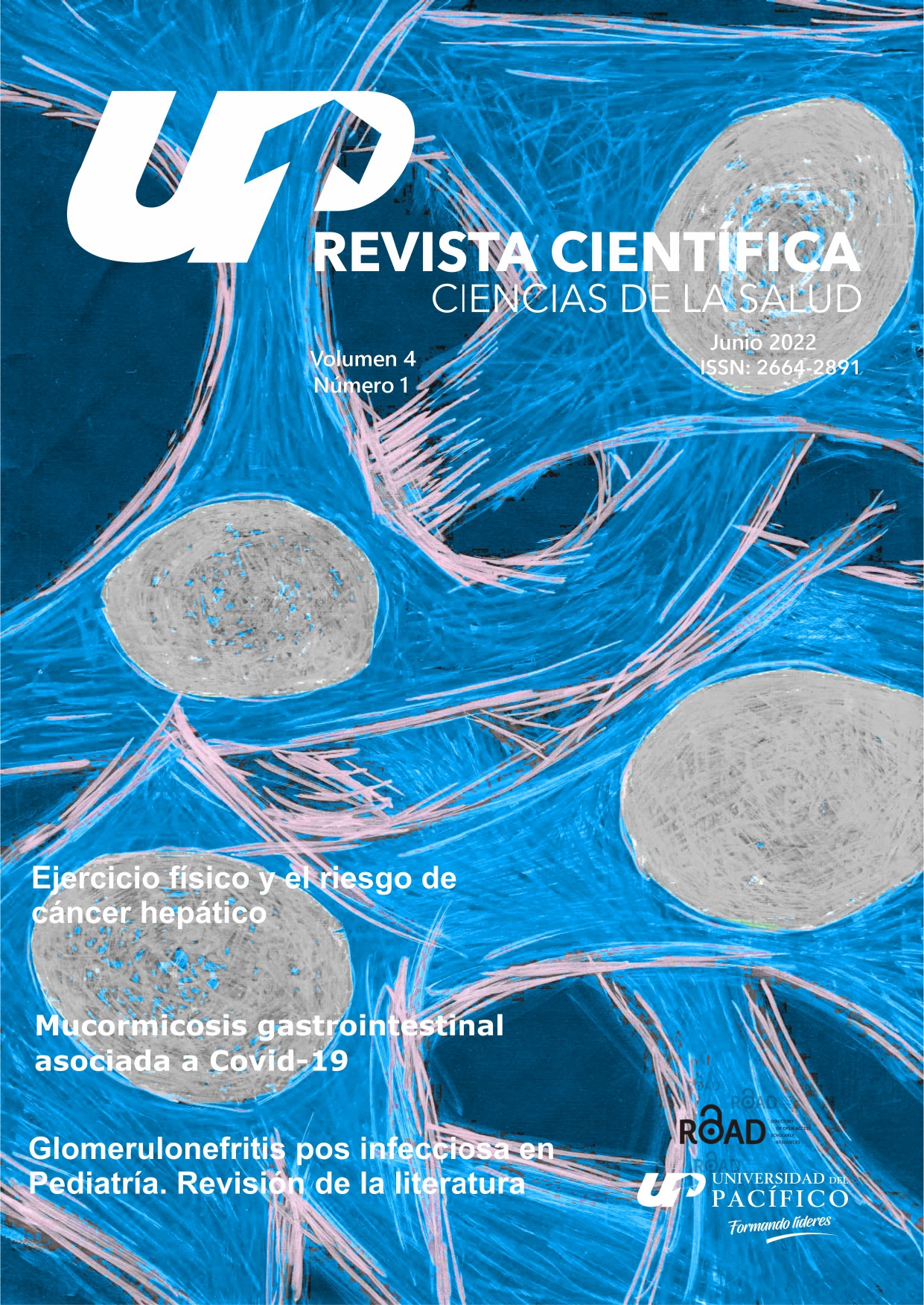The Relevant Aspects on Biomonitoring of Heavy Metal Concentration in Environmental Air in Asunción City
Relevant Aspects on Biomonitoring of Heavy Metal Concentration in Environmental Air in Asunción City
DOI:
https://doi.org/10.53732/rccsalud/04.01.2022.75Keywords:
bryophyta, lead, arsenic, environmental monitoring, mass spectrometryAbstract
Introduction: Briophytes (mosses) have long been used to determine the concentration of heavy metals as an alternative to the collection of atmospheric aerosols. We elaborated the present study to evaluate the environmental concentration of lead, cadmium, mercury and arsenic in autochthonous species of moss exposed during a period to urban environment and to analyze some methodological aspects of biomonitoring in Paraguay.
Material and methods: In an observational study moss samples were obtained from Cerro Patiño (34.4km from Asuncion) to be transplanted in 5 sites of high vehicular traffic in the city of Asunción. One of the samples was taken as control (Moss control 1). The samples were left outdoors for 58 days (2 September 2013 - 29 October 2013) and then collected and subjected to study using the Inductive Coupling Plasma Source Mass Spectrometry technique. The bryophytes were characterized and recorded all the climatological variables that occurred during the study period. A second sampling phase of control moss was required (Moss control 2).
Results: After 58 days of exposure, lead and arsenic levels were detected. The bryophytes used belonged to two families: hypnaceae and pilotrichaceae. The range of temperature, relative humidity, wind and precipitation did not reach extreme levels during the cycle studied.
Discussion: Discrete levels of lead and arsenic are detected in the samples studied here and could represent the studied areas, although other research on variation within and between the moss species of our country is necessary.
References
Centro Mario Molina. Plan de acción para combustibles y vehículos más limpios en Paraguay. 2011.
Jarup L. Hazards of heavy metal contamination. British Medical Bulletin. 2003; 68(1):167-82. https://doi.org/10.1093/bmb/ldg032
Harmens H, Norris D, Koerber G, Busea A, Steinnes E, Rühlingc A. Temporal trends (1990 - 2000) in the concentration of cadmium, lead and mercury in mosses across Europe. Environmental Pollution. 2008; 151(2):368-76. https://doi.org/10.1016/j.envpol.2007.06.043
Asif N, Malik MF, Chaudhry FNA. Review of on Environmental Pollution Bioindicators. Pollution. 2018; 4(1):111-8.
https://doi.org/10.22059/poll.2017.237440.296
Pearson J, Wells DM, Seller KJ, Bennett A, Soares A, Woodall JM, et al. Traffic exposure increases natural 15N and heavy metal concentrations in mosses. New Phytologist. 2000; 147:317-26. https://doi.org/10.1046/j.1469-8137.2000.00702.x
Stankovic J, Sabovljevic A, Sabovljevic M. Bryophytes and heavy metals: a review. Acta Bot. Croat. 2018; 7(2):109–18. https://doi.org/10.2478/botcro-2018-0014
Vukokevic V, Sabovljevi M, Jovanovic S. Mosses accumulate heavy metals from the substrata of coal ash. Arch. Biol. Sci. 2005: 57(2):101-6. https://doi.org/10.2298/ABS0502101V
Mazzoni A, Lanzer R, Bordin J, Schäfer A, Wasum R. Mosses as indicators of atmospheric metal deposition in an industrial area of southern Brazil. Acta Bot. Bras. 2012; 26(3):553-8. https://doi.org/10.1590/S0102-33062012000300005
Steinnes E, Johansen O, Royset O, Ødegård M. Comparison of different multielement techniques for analysis of mosses used as biomonitors. Environ Monit Assess. 1993: 25(2):87-97. https://doi.org/10.1007/BF00549130
Buck W, Norris D. Pleurocarpous Mosses of the West Indies. The Bryologist. 1999; 102(1):156-7. https://doi.org/10.2307/3244482
Klos A, Czora M, Rajfur M, Wacławek M. Mechanisms for Translocation of Heavy Metals from Soil to Epigeal Mosses. Water Air Soil Pollut. 2012; 223(4): 1829-36. https://doi.org/10.1007/s11270-011-0987-2
Blagnytė R, Paliulis D. Research into Heavy Metals Pollution of Atmosphere Applying Moss as Bioindicator: a Literature Review. Environmental Research, Engineering and Management. 2010; 54(4): 26-33. https://erem.ktu.lt/index.php/erem/article/view/93
Noriega P, Medici A, Bedon J et al. Study of the concentration of cadmium and lead in the air of the city of Quito, emplaned bryophytes as biomonitors. La Granja. 2008: 8(2):17-24. https://doi.org/10.3390/life11080821
Kalač P. Trace element contents in European species of wild growing edible mushrooms: A review for the period 2000-2009. Food Chemistry. 2010; 122(1):2-15. https://doi.org/10.1016/j.foodchem.2010.02.045.
Berg T, Perdersen U, Steinnes E. Environmental indicators for long-range atmospheric transported heavy metals based on national moss surveys. Envir Monit and Assess. 1996; 43:11-17. https://doi.org/10.1007/BF00399567
Rossi E. Low Level Environmental Lead Exposure - A Continuing Challenge. Clin Biochem Rev; 2008: 29(2): 63-70. https://www.ncbi.nlm.nih.gov/pmc/articles/PMC2533151/
Janardhana-Raju N. arsenic in the geo-environment: A review of sources, geochemical processes, toxicity and removal technologies. Environmental Research. 2022; 203, 111782. https://doi.org/10.1016/j.envres.2021.111782
Plumlee, G.S., Martin, D.A., Hoefen, T., et al. Preliminary analytical results for ash and burned soils from the October 2007 southern California Wildfires: U.S. Geological Survey Open-File Report 2007-1407. https://pubs.usgs.gov/of/2007/1407/pdf/OF07-1407_508.pdf
Zimmermann LNL, Eisenkölbl Closs AR, Amarilla Rodríguez SM. Dinámica de incendios forestales en la Reserva para Parque Nacional San Rafael, Paraguay, periodo 2007-2017. Rev. Soc. cient. Parag. 2021; 26(1):17-34. https://doi.org/10.32480/rscp.2021.26.1.17
Onianwa, PC. Monitoring Atmospheric Metal Pollution: Review of the Use of Mosses as Indicators. Environ. Monit. Assess. 2001; 71:13-50. https://doi.org/10.1023/a:1011660727479.
Thöni L, Schnyder N, and Kreig F. Comparisons of Metal Concentrations in Three Species of Mosses and Metal Freights in Bulk Precipitations. Fresenius J. Anal. Chem. 1996; 354:703-708. https://doi.org/10.1007/s0021663540703.
Zeichmeister, H, Hohenwallner, D., Riss, A. et al. Variation in Heavy Metal Concentrations in the Moss Species Abietinella Abietina (Hedw.) Fleisch According to Sampling Time, Within Site Variability and Increase in Biomass. Sci. Total Environ. 2003; 301:55-65. https://doi.org/10.1016/s0048-9697(02)00296-6
Berg T, Røyset O, and Steinnes E. Moss Hylocomium Splendens Used as Biomonitor of Atmospheric Trace Element Deposition: Estimation of Uptake Efficiencies. Atmos. Environ. 1995; 29:353-360. https://doi.org/10.1016/1352-2310(94)00259-N
Fernandez JA, Boquete MT, Carballeira A and Aboal JR. A critical review of protocols for moss biomonitoring of atmospheric deposition: Sampling and sample preparation. Science of the Total Environment. 2015; 517(1):132-150. https://doi.org/10.1016/j.scitotenv.2015.02.050


.png)














 All the contents of this journal are licensed under a
All the contents of this journal are licensed under a 